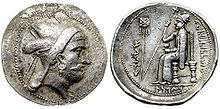- Bagadates I
-
Bagadates I (from the Old Iranian Baga-data, "Given by the gods"),[3] also Bagdates or Baydad, was a frataraka or "Keeper of the Fire", and a governor or sub-dynast for the Seleucids, ruling as a priest-king at Istakhr in the former Achaemenid heartland, the territory of Persis (Fars), after Alexander's conquests. He was the first indigenous Persian satrap to be appointed - or at least tolerated - by the Seleucids,[4] who held the higher administrative posts tightly within the Greco-Macedonian circle that was headed by the "Companions" and their heirs.[5] On the reverse of his coins, Bagadates is depicted standing in front of a Zoroastrian fire-altar, or seated in majesty holding a staff of authority and possibly a pomegranate in his left hand (illustration, left). Bagadates seems to have asserted his independence about 280 BCE, exploiting the turmoil after the death of Seleucus I. "That the first oriental reaction to Macedonian rule should come from Persis, the homeland of the Achaemenids, is hardly surprising," Otto Mørkholm remarks.[6] The uprising against Seleucid control was continued by Bagadates' son, Oborzos,[7] who emphasized the continuity by repeating the coinage type established by his father. However, some time during the third century the Seleucids terminated the pseudo-independence of Persis; during the 220s BCE, the satrap there was a Greek named Alexander, a brother of Molon. Persis finally drifted away from Seleucid control after the battle of Magnesia in 190 BCE.
In a surviving inscription at Amyzon in Caria, another Bagadates was appointed neokoros of the Temple of Artemis there in 321; it is surmised that his family had been potent landowners in the region before the conquests of Alexander.[8] The son of this Bagadates, Ariaramnēs,[9] succeeded him as neokoros at Amyzon.
Notes
- ^ Otto Mørkholm, Early Hellenistic Coinage: From the Accession of Alexander to the Peace of Apamea (Cambridge University Press) 1991:73f.
- ^ John Curtis, Nigel Tallis and Béatrice André-Salvini, Forgotten Empire: The World of Ancient Persia 2005:258-9, fig. 454, Silver tetradrachm of Bagadates.
- ^ Since the Greek equivalent would be Theodore, it will be easily understood that there were numerous individuals bearing this name; the name of one who appears briefly in Josephus, Jewish War is discussed by Tal Ilan and Jonathan J. Price, "Seven Onomastic Problems in Josephus' 'Bellum Judaicum'", The Jewish Quarterly Review New Series 84.2/3 (October 1993: 189-2) p 196f.
- ^ (History of Iran) Jens Jacobson, "Seleucid Empire" 2004
- ^ F. W. Walbank, The Hellenistic World (Harvard University Press) 1981: "The Seleucids and the East", passim.
- ^ Mørkholm 1991:74.
- ^ The historian Polyaenus records a stratagem of Oborzos against Hellene colonists in Persis, noted by Mørkholm , op.cit..
- ^ For instance, in Susan Sherwin-White and Amelie Kuhrt, From Samarkand to Sardis: A New Approach to the Seleucid Empire (London: Duckworth) 1993; see also P. Briant, "Les iraniens de l'Asie Mineure après la chute de l'empire achéménide", Dialogues de l'histoire ancienne 11 (1985:195).
- ^ His name recalls Ariaramnes of Persia, uncle of Cyrus the Great.
Categories:- History of Iran
- Seleucid satraps
- Achaemenid people
- Persian history
- Hellenistic Caria
Wikimedia Foundation. 2010.


